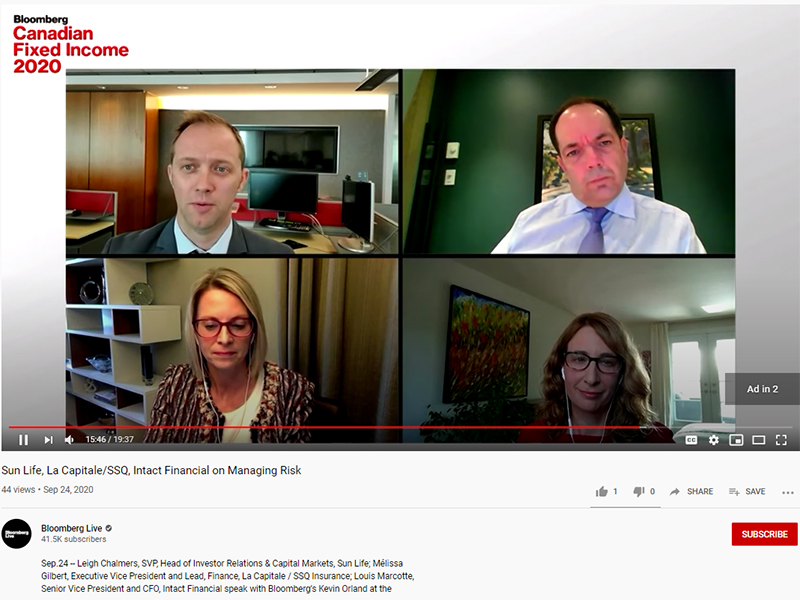
How insurers are shifting investment strategies amid the pandemic
September 30, 2020 by Greg Meckbach

Print this page Share
Changing the mix of real estate portfolios, selling international exposures and considering increasing insurance prices are among the measures Canadian insurers are taking to compensate for the impact of COVID-19 on investment results.
Intact Financial Corp.’s investment portfolio turns over about every six to seven years, CFO Louis Marcotte said during the recent Bloomberg Canadian Fixed Income Conference.
Marcotte was one of three insurer CFOs asked about the major shift in financial markets resulting from the COVID-19 pandemic and the persistently low interest rates.
“Fortunately, with one-year policies, we are able to re-price on the underwriting side and offset some of that pressure. So we feel we are in good shape here, to maintain a mid-teens [return on equity] level as we have in the past,” Marcotte said during the virtual panel Sept. 24.
There is some uncertainty about how the economic impact of the pandemic will affect investment income in future quarters, said Marcotte.
“We came into the crisis with a portfolio that had about 24% equities and preferred shares. Of course, it was tough during Q1, but we took the decision to reduce that portfolio, sold some of our international exposures and actually, in Q2, we hedged some of the equity exposures so that today our common equity went from roughly 14% to 10% of total investment assets.”
COVID-19 was declared a pandemic by the World Health Organization on March 11. During the weeks before and after March, equity markets took a beating but many stocks have since regained much of the loss.

iStock.com/MicroStockHub
During the three months ending March 31, Intact reported net losses on investments of $21 million. But in the quarter ending June 30, Intact reported net gains of $144 million, up from $60 million in Q2 2019. So Intact’s investment portfolio returned to an unrealized gain position, as of June 30, following what Intact describes as a significant improvement in financial markets in Q2 2020, the company said this past July in a securities filing.
For Canada’s P&C insurers, net investment income dropped 28.7%, from $2.335 billion in Q2 2019 to $1.666 billion in Q2 2020, the Property and Casualty Insurance Compensation Corporation reported in its Solvency Matters newsletter released Sept. 23. PACICC was quoting data from MSA Research Inc.
The Bank of Canada announced on Sept. 9 that it’s maintaining an overnight rate of 0.25%, down from 1.75% on Jan 22. In Canada, real GDP fell by 11.5% (39% on an annualized basis) in the second quarter, the central bank said in explaining why low interest rates are good for the economy as a whole.
Since January, the Bank of Canada has reduced the overnight interest rate three times. It dropped the rate half a percentage point each on March 4, 16 and 27. This makes it harder for insurers to make money by investing their capital in interest-bearing investments. The overnight rate had steadily risen until January of 2020 – from 0.5% in 2017. But even January’s 1.75% was down from historic levels, such as 4.5% in 2007 and more than 20% in the summer of 1981.
For Canada’s largest mutual insurer (including life), the impact of the current financial markets and interest rates was “not that high on our results,” said Mélissa Gilbert, executive vice president and lead, finance at Quebec City-based La Capitale/SSQ Insurance.
“We have been careful about illiquidity ratio and we made small changes in the investment portfolio but nothing that I would say is significant,” Gilbert said during the Bloomberg Canadian Fixed Income Conference.
For its part, Sun Life increased the quality of its commercial mortgage book from BBB to A, said Leigh Chalmers, Sun Life’s senior vice president and head of investor relations and capital markets.
“Everyone anticipated something was coming and, as a result, we really started to re-position our balance sheet, said Chalmers.
For example, Sun Life re-positioned its real estate portfolio — from indoor to outdoor malls for example. It also reduced its exposure in Alberta to oil and gas.
“We positioned ourselves well to take advantage of higher-yielding returns.”
Have your say: